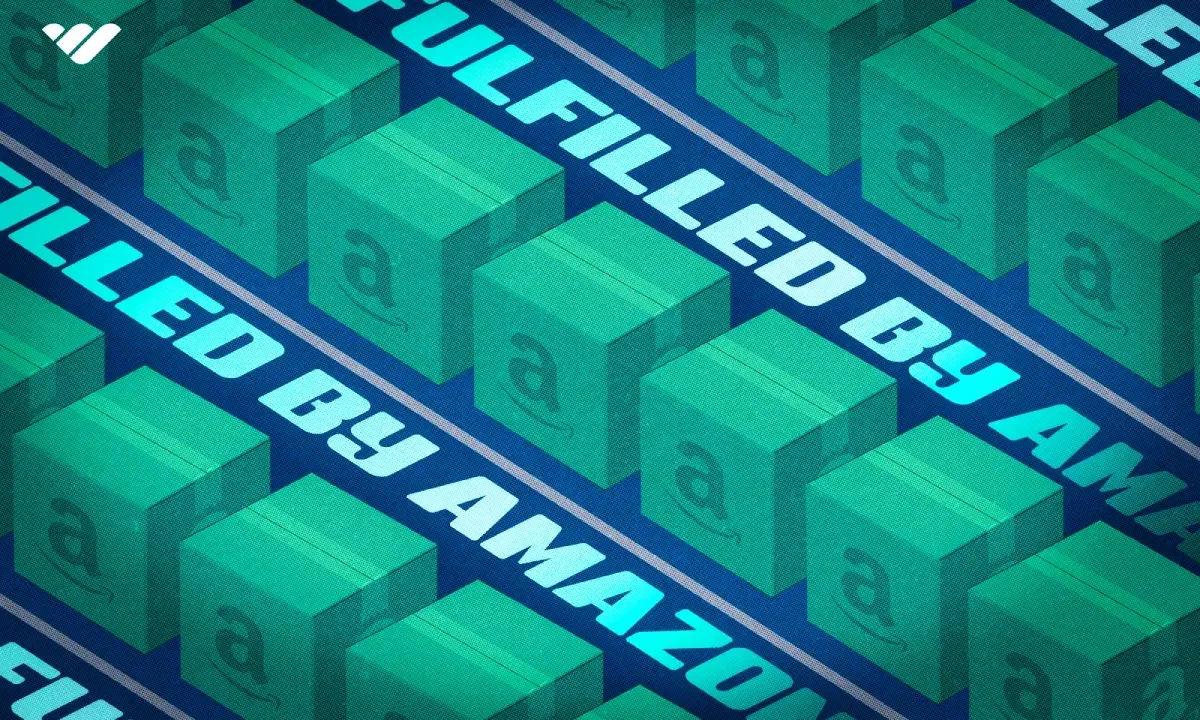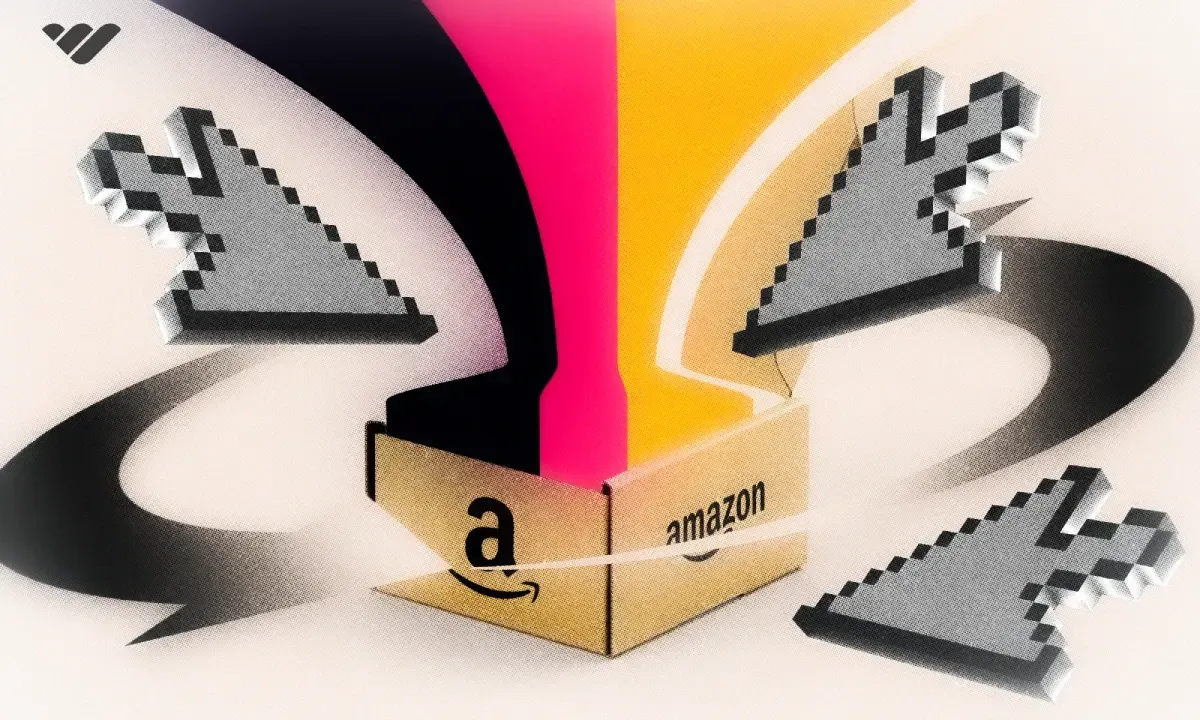As an ecommerce entrepreneur, you’ll have to master the many moving parts of your operation - from sourcing inventory to payment processing, keeping customers happy, and, of course, fulfillment.
Fulfilling inventory can be one of the most time and cost-intensive parts of running an ecommerce business, so many owners seek to outsource part or all of the process to third parties to help them scale more efficiently.
Fulfillment by Amazon, also known as Amazon FBA, has emerged as an attractive option for ecommerce entrepreneurs looking to streamline their fulfillment while utilizing the power and reach of Amazon’s platform and logistics network.
But what is FBA and how does it work? This comprehensive guide will delve into everything you need to know about Amazon FBA, including different business models and a step-by-step guide.
Jump ahead to:
- What is Amazon FBA?
- How Does Amazon FBA Work?
- Amazon FBA Business Models
- Should I Sell With Amazon FBA?
- How to Start Amazon FBA
- Amazon FBA Tips and Tricks - Becoming a Successful Seller
- Explore Amazon FBA Education with Whop
What is Amazon FBA?
First launched in 2006, Amazon FBA is a program that allows third-party sellers to take advantage of Amazon’s efficient fulfillment and logistics network, which includes a vast number and location of warehouses and fast Prime shipping.
It is a paid, premium service for sellers and is continually improving to increase efficiency and streamline all aspects of fulfillment so that store owners can scale without worrying about having to store, pack, pick, and ship inventory on their own.
How Does Amazon FBA Work?

Amazon FBA works by allowing sellers who choose to sign up for the program to leverage the company’s extensive warehouses, efficient logistics, and customer service to handle all aspects of fulfillment for product sales they make. Let's take a quick look at the Amazon FBA process:
- Once the seller has paid to enroll in the program, they will receive instructions on how to send their inventory to Amazon for fulfillment, including packing instructions and shipping labels.
- The seller will then be able to track the status of individual fulfillment and sales within their seller dashboard and enjoy the hands-off benefit of using the FBA program.
- FBA also provides some customer service including handling returns and addressing basic inquiries that come after an order has been placed.
It’s worth noting that the service comes with fees that can end up taking up a substantial portion of the potential profit margin, so sellers should only use the service if they can remain profitable after taking all fees into account.
Amazon FBA Business Models
When selling with Amazon FBA, you can choose several different business models. Here are the most common and profitable models that you can choose from:
Retail Arbitrage
One of the quickest ways to start utilizing Amazon FBA is through retail arbitrage. With retail arbitrage, there’s no need to create or even market a product: for the most part, you’ll be selling brand-name products that are already in demand. Keep in mind though that there will likely be many other Amazon sellers to compete against if an item is popular and profitable.
While retail arbitrage is an attractive business model, you first need to be approved to sell your intended product on Amazon. The company holds a high standard for sellers, so not everyone can create a listing: you’ll need to be approved, or ungated, to sell specific brands or within certain categories.
Once you have approval to sell these products, you will be able to take advantage of the FBA program as a retail arbitrage reseller.
Private Label
Some FBA sellers will list an original product, which is known as selling private label. Private label selling has the potential to be much more lucrative compared to retail arbitrage since you’re getting product at factory cost, however, you’ll have to generate demand for your product and hedge against competition who may copy you if you reach a certain level of success.
When selling private label, you can simply sell a generic product under a brand name, known as white labeling, or you can invent your own product from scratch. Both of these methods have their own challenges–when white-labeling a product, you can easily be copied, and if you’re inventing a product, you’ll have to invest time, money and effort into establishing demand for your product, which might prove completely fruitless. Creating a product that falls in between these two is often ideal, such as making a minor tweak to a generic product.
Dropshipping
Dropshipping is a business model that can be applied using several platforms, including Amazon FBA.
As a dropshipper, you will be operating a business model that is essentially entirely hands-off as you won’t need to see or touch any of the inventory, even before it goes to FBA for fulfillment.
While dropshipping is allowed using Amazon FBA, you’ll have to meet Amazon’s requirements, which include having an agreement with the supplier that you are an authorized seller of record. You’re best off finding a dropshipper who has already worked with Amazon FBA sellers in the past, and if you have the budget and the arrangement is profitable, you should consider getting an exclusive relationship with a dropshipper to keep direct competition at bay.
Wholesaling
One aspect of ecommerce that is essential to the business model of many companies is wholesaling, which is the process of dealing in bulk quantities for lower pricing. As an FBA seller, you can be dealing in wholesaling as either a buyer or a seller. Most sellers will find wholesale suppliers as a source of inventory that they can split up and sell individually.
Becoming a wholesaler on Amazon FBA requires a large budget as you will need to buy items in huge quantities in order to sell profitable batches. While there’s a much larger investment in becoming a wholesaler, as a B2B supplier, you will benefit from more predictable cash flow in larger quantities once you are established.
Should I Sell With Amazon FBA?
Selling on Amazon FBA isn’t for everyone. In fact, most beginners should simply fulfill all orders on their own – this is known as fulfilled by merchant, or FBM. The main reason that novice Amazon sellers shouldn’t sell with FBA is because of the extensive fees involved.
Before upgrading your account to using FBA, you’ll want to hit the following milestones:
- Consistent and loyal customer base with predictable revenue
- Healthy profit margins that allow room for financial investment
- Self-fulfillment is overwhelming
- You’re at a point where you need to start delegating in order to scale
If your business hasn’t yet started putting you in the position of any of the previously mentioned points, it is probably not worth selling using Amazon FBA, and you should continue to fulfill inventory on your own. On the contrary, if most or all apply to you, selling on FBA can be a huge benefit and can allow you to scale to reach your ambitions.
How to Start Amazon FBA

Before you start Amazon FBA, you have to first prepare yourself and your business. In this section we outline how to prepare yourself to start selling with Amazon FBA, how to move inventory, scale your business, and ultimately find success as an Amazon seller!
1- Before you start selling: Setting up on Amazon
If you intend to sell on Amazon, you’ll also want to formally register yourself as a business so that you can be billed and taxed properly. You’ll use this info to set up a business bank account and get a Tax ID that you’ll use to associate with your account.
After you’ve done that, the first step to getting started with Amazon FBA is setting up your account properly, which starts by signing up for an account and your selling plan.
A seller must sign up as a Professional Seller, which requires a monthly subscription of $39.99, and meet some minimum seller requirements in order to be eligible to use FBA.
If you are a private label seller with your own brand name, you should take advantage of Amazon’s Brand Registry. In order to do this, you’ll have to go to Seller Central and enter your brand name and product categories, and provide documents proving your ownership. It’s worth noting that you’ll need a registered trademark in order to be eligible, so get on this process as early as possible so you can apply quickly.
Once you’ve been approved, you’ll be able to protect yourself from sellers that blatantly copy your brand or violate any intellectual property rights by gaining access to reporting tools that help identify and remove violations.
2- Picking a business model and product
Settle on one of the previously described business models that fits your situation best based on the opportunities that you have access to.
Whichever model you choose, be sure to thoroughly research and validate for sufficient demand and profit potential, and invest only the amount necessary to be profitable, especially in the beginning when you’re not sure how quickly your inventory will move and if prices will change.
Your chosen business model will dictate which product you choose. Ideally, you’ll want to sell one that is cheap to ship and easy to maintain, so something small and durable is best as it will lower fulfillment costs and return rates.
3- Optimizing your listings
Now that you’ve set up your account and chosen your business model, you’ll have to get your account ready to be an efficient FBA sales channel. Be sure to make the best listing you can so that you can stand out from the competition. Optimize your titles, descriptions, images and keywords according to Amazon’s guidelines so that you’ll gain maximum visibility through a higher ranking. Double-check for accuracy in terms of both description and quantity.
When it comes to pricing, you always need to be aware of the price range of existing listings so that you can be profitable while at the same time competitive. Factor in all fees using calculating tools to project profitability. To be further prepared, you can utilize software such as Helium10 or Jungle Scout that will give you actionable insights on competitor data and opportunities based on keyword volume, revenue, and potential profitability.
4- Choosing your fulfillment method
If selling with Amazon FBA fits with your business model and the current state of your business, you’ll want to make the switch over to it to use as your primary fulfillment method.
Once you have a Professional seller account, you simply need to select Fulfill By Amazon when configuring each product listing in order to make them eligible.
You’ll receive instructions on how to pack your products and where to send them, complete with shipping labels.
Your product will then be received by Amazon’s warehouses and prepped for individual shipping. Amazon FBA will handle the following:
- Unpacking and inspection of inventory
- Storage of inventory
- Picking, packing and shipping via Prime
- Customer service after purchase
- Processing of returns and refunds
Keep in mind that you’ll have to pay an ongoing fee for taking up storage space, and this fee increases during busy times such as the holiday season. You’ll have the option to take back inventory for a fee if you don’t want to continue paying for storage, at which point you can choose to send it back to FBA later if it makes sense or to liquidate the inventory through another sales channel.
5- Moving your inventory efficiently and scaling your business
After you’ve set up your account, settled on a product and business model that uses Amazon FBA, and optimized your listings, you’re ready to get your inventory moving. However, if you want to move inventory efficiently and scale into a profitable, growing, business, you’ll have to hit profitability and monitor performance as you continue to operate.
Here are some metrics you’ll need to monitor as you scale:
Profit margin
Profit is the lifeblood of a business–revenue means nothing if you can’t remain profitable. Be sure to create regular reports so that you can assess profitability by calculating the exact profit margin over certain periods of time, such as weekly or monthly. Remember that pricing on Amazon FBA can fluctuate, so it will take some time to forecast whether or not your current business model and strategy will remain profitable in the foreseeable future.
Sell-through rate
The sell-through rate is how many units are sold in proportion to the received inventory. By putting a number on this, you’ll be able to quantify and identify which products are selling quickly or slowly, which will help you to make good investment decisions and determine your order size, buying progressively more products with a high sell-through rate and buying less or none of products on the other end of the spectrum.
Buy box percentage
When selling with FBA using the retail arbitrage business model, you’ll be competing against other sellers for the Buy Box, which means that customers will choose your store by default when clicking “Buy It Now”.
The vast majority of customers will not toggle the seller list to choose someone who does not have the Buy Box, so it’s critical that you have it. Getting the Buy Box is largely determined by the price of the product, with some weight being given to the reputation and history of the seller.
Track the percentage that you have the Buy Box so that you’ll know how successful you are at sourcing profitable product that can sell quickly by being the default option for customers interested in the listing.
Inventory levels
Maintaining proper inventory levels is a constant balancing act that business owners have to make, as you want to stay stocked enough to meet demand while moving enough inventory so as not to take up valuable storage space.
Selling out regularly will lower your sales ranking and chances for having the Buy Box, so it’s important to not cut it too close just to save in the short term.
As a professional-level FBA seller, Amazon will help you with automated forecasts that will help you know when you should order based on sell-through rate. These will become more accurate as you establish more sales history and revenue.
Advertising costs
For sellers who have private label inventory, advertisements are a necessary part of gaining and sustaining brand awareness, especially inside Amazon’s marketplace, which is full of competition.
Advertising has the potential to produce a huge return on investment, but this is only possible if you are strategic with the type of ads you use and your budget.
As an Amazon FBA seller, you can utilize pay-per-click (PPC) ads, brand sponsorships, and influencer marketing. Keep track of metrics such as cost per click (CPC) and return on ad spend (ROAS) to know whether or not to increase or decrease your budget.
Customer reviews
The quantity and quality of your seller and individual product reviews has a huge impact on your long-term business viability. Amazon prides itself on being a top marketplace for reputable sellers, so it holds a high bar with customer satisfaction. Amazon uses metrics including the star rating for your product, direct feedback you receive as a seller, refund rate and return dissatisfaction rate to weight your reputation overall. All of these factors impact your ranking, and the higher you are ranked in your category or for a specific product, the higher your sales will be.
When getting initial reviews, be sure not to violate any of Amazon’s terms of service which now prohibit sellers from offering free or discounted product in exchange for reviews. By selling a high-quality product and following up purchases with a request for a review, you’ll be able to gather the feedback you’ll need to grow your account.
Amazon FBA Tips and Tricks - Becoming a Successful Seller
Building a profitable, long-lasting Amazon FBA business requires a continuous effort to carry out a strategy that allows you to compete and thrive in the largest ecommerce marketplace in the world. Although it’s a lot of work, the payout for those that crack the code can be huge: according to Amazon analytics software JungleScout, an estimated 18% of independent FBA sellers make over $10,000 monthly in sales, with 10% of those sellers doing between $25,000 to $500,000 per month.
So, it’s possible to create a seven-figure business on Amazon as a solopreneur, but rising to the top means that you’ll have to keep the following in mind:
Develop a competitive advantage
Amazon is the number one online marketplace in the world, so you’ll be competing against the best sellers in the world who are all vying for a slice of the huge pie of the trillion dollar company.
You’ll have your best shot of competing if you carve yourself a niche and create a competitive advantage that hedges against any potential competition. Your advantage can come in the form of a unique product, a low-key, profitable source of inventory, bundle offerings, or innovative product variations.
Continuously track metrics and iterate accordingly
Amazon’s marketplace is full of data, and while this can be overwhelming, the most profitable sellers take advantage of the rich datasets and organize and track relevant metrics so that they can make informed decisions that help their FBA business flourish.
Keep spreadsheets so you can quickly visualize key metrics such as your ROI, ROAS, monthly revenue, profit margins, reviews, competition, and more. Tools like Jungle Scout and Helium 10 can help you gain a clearer picture of the overall marketplace, including metrics from competitors. Use these insights to create and adjust your goals.
Reinvest for growth
As with any investment vehicle, creating a snowball effect by reinvesting will allow you to reap the benefits of compounding and grow your business to impressive heights. Rather than pocketing the excess cash, think of ways that you can feed and grow your Amazon business. Make a list at the beginning of things that your business could invest money into, and as you grow, slowly start allocating capital to each of these areas until you have a money-making machine. These areas could include larger quantities of bulk inventory for cheaper pricing, a unique, private-label product, and a healthy advertising budget.
Strategically scale
All successful entrepreneurs in any realm deliberately scale. You can’t go somewhere if you don’t create a roadmap to get there, so from the beginning, write out a detailed plan of how much you intend to make and how you can realistically reach those goals based on current marketplace data of competing sellers.
Start small but scale at a sustainable pace as your revenue and operational breadth and capabilities increase. This might involve buying in larger quantities if you have a high sell-through rate, or expanding into different categories, geographical locations, or even adding sales channels beyond Amazon.
The earlier you make this plan and see it through to an ambitious goalpost, the more likely you will be to create an Amazon business that succeeds to impressive levels.
Explore Amazon FBA Education with Whop

Succeeding at Amazon FBA is more competitive than ever, making it an unforgiving playing field where only the best survive. Since Amazon selling is such a high-level game full of potential missteps, it’s smart to seek guidance to help you succeed. However, it can be difficult to find direct mentorship from a successful Amazon FBA seller, and even if you manage to get a hold of one, the cost for consultation will likely be quite high–that is, if they even offer it.
Thankfully, some successful Amazon FBA sellers have given back in the form of creating dedicated private communities that allow beginners to learn from their time-tested strategies and shortcut their path to success. So, if you want to get started on your Amazon FBA journey inside of an expert-led group, check out one of the many communities on Whop that can help you meet your goals. Check out the FBA-focused Whop communities and get started on the lucrative path of being an Amazon seller today!





